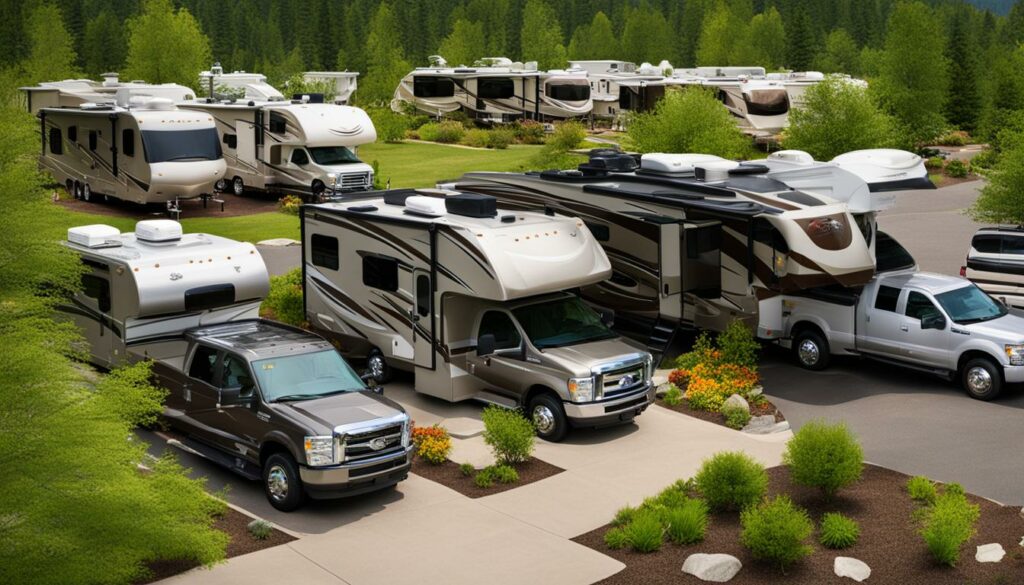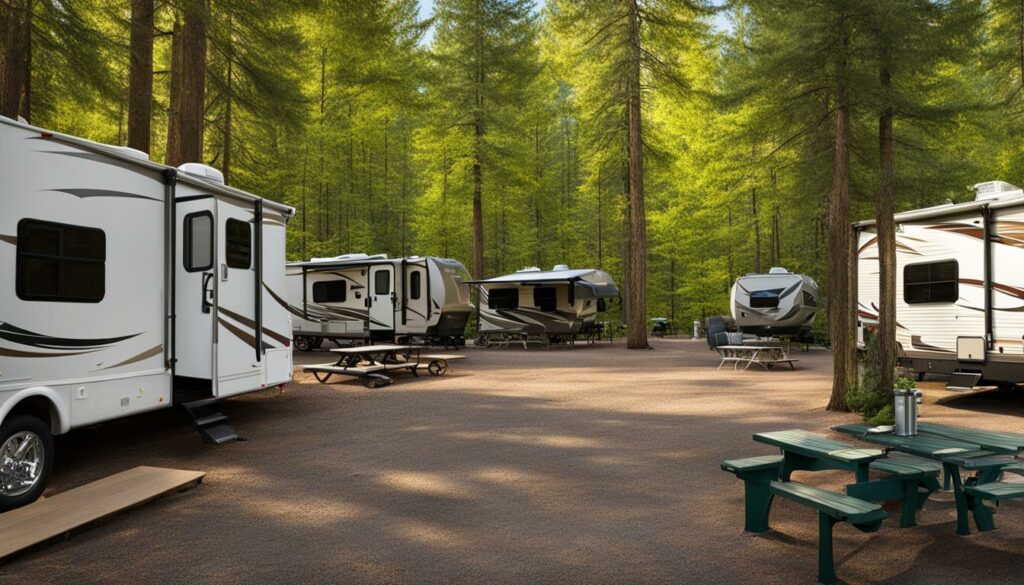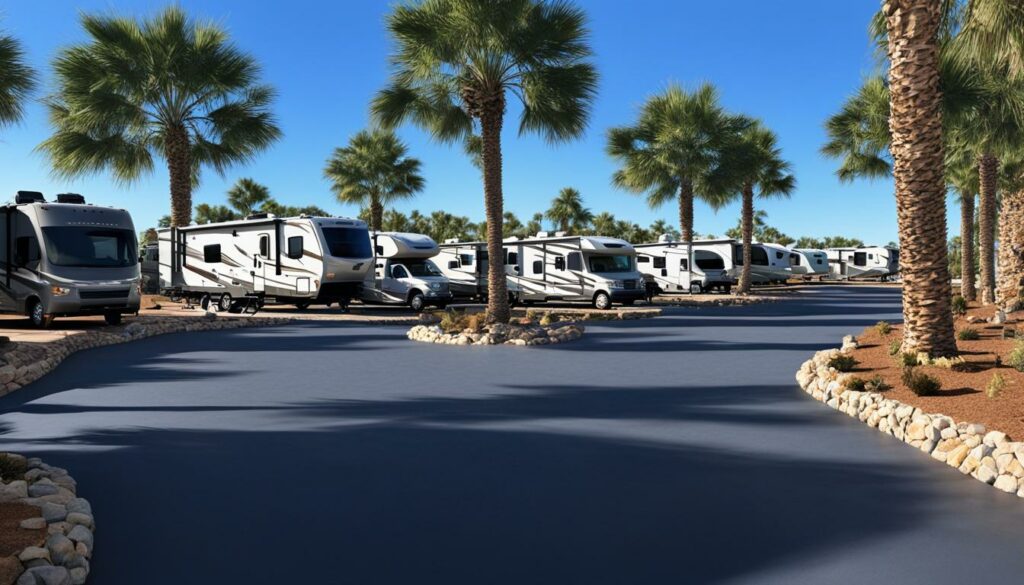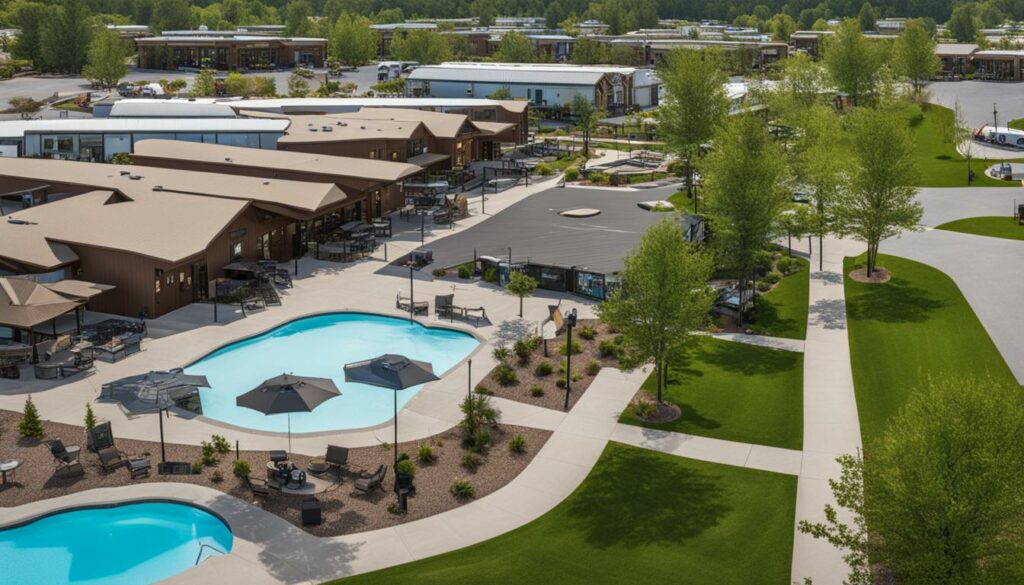Mobility-friendly RV resorts are essential to create an inclusive camping experience for all individuals. These resorts are designed to cater to people with disabilities, making camping accessible and enjoyable for them. To create these resorts, several considerations need to be taken into account.
Key Takeaways
- Designing mobility-friendly RV resorts is crucial for inclusive camping experiences for all individuals.
- These resorts cater to people with disabilities, making camping accessible and enjoyable for them.
- Several considerations need to be taken into account while designing these resorts.
- Designing accessible facilities and amenities, creating barrier-free campsites and enhancing navigation and signage are some of the key considerations.
- Partnering with accessibility organizations and training staff in disability awareness can further enhance the camping experience of individuals with disabilities.
Understanding Accessibility Requirements

Designing mobility-friendly RV resorts requires a thorough understanding of accessibility requirements. Wheelchair-friendly RV campgrounds and ADA-compliant RV campgrounds are the key considerations for creating inclusive camping experiences for individuals with disabilities.
Wheelchair access is a fundamental requirement for any RV resort, and offers many benefits to individuals with mobility impairments. ADA-compliant RV campgrounds extend accessibility features beyond simple wheelchair access, to adhere to a comprehensive accessibility standard. These campgrounds provide a range of accessible facilities including restrooms, showers, parking, campsites, and amenities to ensure mobility-impaired guests can comfortably access the full range of resources available to other visitors.
In addition, creating an inclusive environment involves designing for accessibility across a range of different disabilities, including visual and auditory impairments. For example, appropriate signage, text size, color contrasts, and captions for audio content can help improve access for guests with visual and hearing impairments.
RV resort owners and operators should also consider partnering with accessibility organizations to better understand the needs and preferences of individuals with disabilities.
Key Accessibility Considerations for Mobility-Friendly RV Resorts
| Accessibility Features | Examples |
|---|---|
| Wheelchair Accessible Facilities | Accessible parking, walkways, restrooms, showers, and campsites |
| Accessible Amenities | Accessible swimming pool, picnic area, playground, and other recreational facilities |
| Visual Accessibility | Appropriate signage, high-contrast text, alternative text for images, sound indicators, and Braille signage |
| Hearing Accessibility | Captions for video and audio content, induction loops, visual alerts, and visual alarms |
| Partnering with Accessibility Organizations | Collaborating with organizations such as the National Council on Independent Living, the National Organization on Disability, and The Ability Center for expert advice and resources |
Designing Accessible Facilities and Amenities

When designing RV resorts for people with disabilities, accessibility is a crucial consideration, especially in the design of facilities and amenities. Handicap-accessible camping facilities, such as restrooms and showers, are a necessity for ensuring that individuals with disabilities have a comfortable and safe camping experience.
Accessible common areas are also important, as they enable individuals with mobility impairments to move around freely and enjoy all that the RV resort has to offer. This includes facilities such as pools, community centers, and outdoor recreation areas that have wheelchair ramps and are equipped with assistive devices, such as pool lifts and beach wheelchairs.
In addition, providing amenities that cater to the specific needs of individuals with disabilities can help to ensure a memorable and enjoyable camping experience. This includes features such as accessible trails, sightseeing tours, or camping sites equipped with accessible fire pits and grills.
| Accessible Facilities | Description |
|---|---|
| Accessible Restrooms | Wide doors, grab bars, and raised toilets |
| Accessible Showers | Roll-in showers, grab bars, and fold-down seats |
| Accessible Common Areas | Wheelchair ramps, assistive devices, and smooth surfaces |
| Accessible Trails | Gravel-free pathways, lower inclines, and wheelchair accessible |
Designing accessible facilities and amenities within RV parks with amenities for disabled individuals is crucial to creating an inclusive and memorable experience for individuals with disabilities. By providing accessible restrooms, showers, and common areas, as well as catering to the specific needs of individuals with disabilities, RV resorts can create a welcoming environment that can be enjoyed by all.
Creating Barrier-Free Campsites

Designing barrier-free campsites is crucial in creating inclusive RV resorts. For mobility-impaired guests, RV resorts must consider the design elements of their campsites to ensure accessibility. For instance, campsites should offer level access and wider spaces for wheelchairs and mobility aids. Accessible hook-ups are also important to ensure guests can comfortably connect and use their RVs.
RV resorts equipped for mobility-impaired guests must provide accessible tents and RV rentals, equipped with essential features. The tents should have wider entrances, level floors, and accessible roll-in showers. The RVs should be designed to accommodate various mobility challenges, with comfortable and accessible arrangements.
Creating a barrier-free campsite involves widening the roads and enhancing the site’s grading. The road needs to be clear and wide enough to allow easy movement of RVs and mobility aids. The campsites and roads should also be well-lit, and the path from the campsite to the restrooms and other facilities should be seamless.
Enhancing Navigation and Signage

Clear navigation and signage are crucial components of mobility-friendly RV resorts. These features aid individuals with disabilities in maneuvering through the resort and accessing the necessary facilities and amenities.
Accessible pathways are an essential aspect of navigation. Level access, smooth surfaces, adequate lighting, and clear signage all facilitate movement for individuals with disabilities. Signage with large fonts and visual symbols is particularly helpful for individuals with vision impairments.
RV park operators should prioritize enhancing navigation and signage to ensure that the resort is accessible and inclusive for individuals with disabilities. This could involve conducting audits of the resort to identify areas of improvement. Additionally, staff members should receive training on how to assist individuals with disabilities and answer questions about the resort’s accessibility features.
Training Staff in Disability Awareness
Creating a truly inclusive RV resort experience requires a staff that’s knowledgeable about disability awareness and can provide assistance and support to all guests. By investing in staff training, you can ensure that your mobility-friendly RV resort is not only accessible but also welcoming to individuals with disabilities.
Staff members should be trained to understand the different types of disabilities and how to provide assistance in a respectful and considerate manner. They should also be aware of the accessible features within the resort and be able to provide guidance and support to guests with disabilities.
Training can take many forms, from in-person seminars to online courses. It’s important to ensure that all staff members, including front desk staff, housekeeping, maintenance, and management, receive adequate training and understand the importance of disability awareness.
“Our staff training program has been instrumental in creating a welcoming and inclusive experience for all of our guests, including those with disabilities. It has not only improved the guest experience but also made our staff more empathetic and understanding.”
– Jane Smith, Resort Manager at Paradise RV Resort
By investing in staff training, you can create a culture of inclusivity and accessibility within your mobility-friendly RV resort. This will not only benefit guests with disabilities but also enhance the overall experience for all guests.
Providing Equipment and Assistive Devices
RV resorts that cater to individuals with disabilities understand the importance of providing equipment and assistive devices to enhance their camping experience. Accessible RV rentals, mobility aids, and other resources are necessary to ensure that individuals with disabilities can enjoy all the amenities that a mobility-friendly RV resort has to offer.
Accessible RV rentals are an essential feature of mobility-friendly RV resorts, and they provide a comfortable and safe accommodation option for individuals with disabilities. Fully-equipped accessible RV rentals often feature wide doorways, level access, and other accessibility features that make them safe and user-friendly for individuals with disabilities.
In addition to accessible RV rentals, mobility aids such as wheelchairs and mobility scooters are also available for guests to rent at mobility-friendly RV resorts. These devices allow individuals with disabilities to explore the RV resort and surrounding areas, adding to their camping experience.
Other resources such as hearing and visual aids are also provided at RV resorts catering to individuals with disabilities. The staff at these resorts are trained to provide information and assistance on the use and availability of these devices.
Partnering with Accessibility Organizations
Collaborating with disability organizations can provide significant benefits to RV resorts creating mobility-friendly experiences. Such partnerships can lead to increased visibility within the disability community, access to valuable resources, and expert guidance to improve accessibility.
Working together with these organizations can help RV resort owners and operators gain a deeper understanding of the needs and preferences of individuals with disabilities. This, in turn, can help them develop better strategies for accommodating these guests, ensuring a comfortable and hassle-free camping experience.
By partnering with accessibility organizations, RV resorts can tap into a wealth of expertise and knowledge on disability awareness and accommodation. These organizations can offer training programs for staff members, advising resorts on improving accessibility, and accessible equipment rental services.
Collaboration can also lead to opportunities for sponsorship, outreach, and fundraising. RV resorts can become more involved in promoting and supporting initiatives that support accessibility and inclusive camping experiences for people with disabilities.
Overall, partnering with accessibility organizations is a win-win for both RV resorts and disability organizations. It can lead to stronger relationships, higher quality services, and a closer-knit community that places great value on equity and inclusion.
Conclusion
In conclusion, designing mobility-friendly RV resorts is crucial in creating inclusive and accessible camping experiences for individuals with disabilities. It is important for RV resort owners and operators to understand the accessibility requirements and prioritize the design of accessible facilities and amenities, barrier-free campsites, navigation and signage, and providing equipment and assistive devices. Additionally, training staff in disability awareness and partnering with accessibility organizations can enhance the camping experience for individuals with disabilities.
By prioritizing accessibility, RV resort owners and operators can ensure that individuals with disabilities can enjoy the freedom and joy of RV camping. It is important to remember that everyone deserves the opportunity to experience the great outdoors and create lasting memories with loved ones, regardless of their mobility limitations.
FAQ
What are mobility-friendly RV resorts?
Mobility-friendly RV resorts are campgrounds designed to accommodate individuals with disabilities. These resorts have features and amenities that ensure accessibility, allowing people with mobility impairments to enjoy RV camping without barriers.
What makes an RV park handicap accessible?
A handicap-accessible RV park is equipped with features like accessible restrooms, showers, and common areas. It also has level access for RV sites, wider spaces, and accessible hook-ups to accommodate individuals with mobility impairments.
What amenities should I look for in an RV park for people with disabilities?
When choosing an RV park for people with disabilities, look for amenities such as accessible restrooms, showers, and common areas. Additionally, consider whether the park offers services or facilities like accessible rental RVs, mobility aids, and other equipment that enhance the camping experience for individuals with disabilities.
How can I find wheelchair-friendly RV campgrounds?
To find wheelchair-friendly RV campgrounds, look for RV parks that advertise their accessibility features. You can search online for RV parks with wheelchair accessibility or contact local RV associations for recommendations. It’s also helpful to read reviews or reach out to other RVers who may have experience with accessible campgrounds.
What are ADA-compliant RV campgrounds?
ADA-compliant RV campgrounds are designed and operated in compliance with the Americans with Disabilities Act (ADA). These campgrounds meet specific criteria to ensure accessibility for individuals with disabilities, including features like ramps, wider doorways, and accessible paths of travel.
Why is it important to have accessible camping facilities?
Accessible camping facilities are important to ensure that individuals with disabilities can fully enjoy the camping experience. By providing accessible restrooms, showers, and common areas, RV parks can create an inclusive environment that promotes independence and equal opportunities for all campers.
What are some design considerations for accessible RV resorts?
Design considerations for accessible RV resorts include level access for RV sites, wider spaces to accommodate mobility devices, and accessible hook-ups. The resort should also have clear navigation and signage, visibility aids like contrasting colors and large fonts, and pathways that are free of obstacles.
How can RV parks enhance navigation and signage for individuals with disabilities?
RV parks can enhance navigation and signage for individuals with disabilities by providing clear signage with large fonts and visual symbols. Accessible pathways should be created, featuring smooth surfaces, handrails, and tactile indicators where necessary. This ensures that individuals with disabilities can easily maneuver through the resort.
Why is training staff in disability awareness important for inclusive RV resorts?
Training staff in disability awareness is important for inclusive RV resorts to ensure that all guests receive the necessary support and assistance. This includes understanding the unique needs of individuals with disabilities, providing accommodations, and fostering an inclusive and welcoming environment for everyone.
What equipment and assistive devices should be provided in RV resorts for people with disabilities?
RV resorts for people with disabilities should provide equipment and assistive devices such as accessible RV rentals, mobility aids, and other resources that enhance the camping experience. These offerings help individuals with disabilities overcome barriers and access all the amenities and activities available within the resort.
Are there benefits to RV resorts collaborating with disability organizations?
Yes, there are many benefits to RV resorts collaborating with disability organizations. Partnering with these organizations provides access to resources, expertise, and increased visibility within the disability community. It can also lead to valuable insights and guidance on how to make the resort more inclusive and accommodating for individuals with disabilities.





